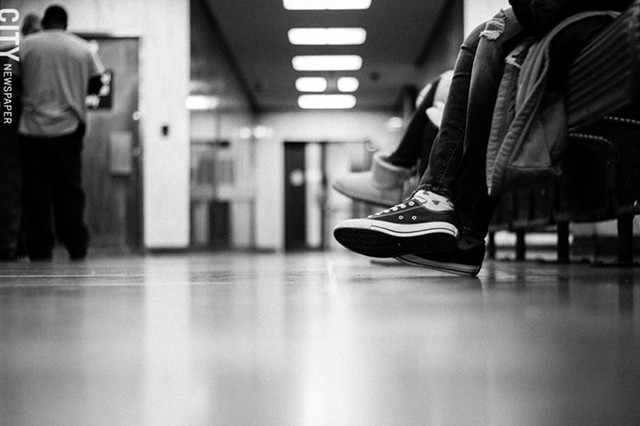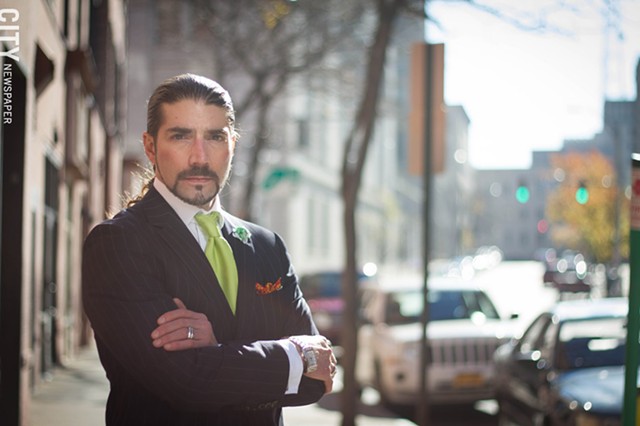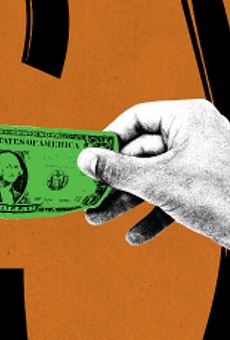Stuck in jail for a month or more, the man's schizophrenia worsened. He started to hallucinate, developed severe paranoia, and lost a ton of weight.
He was accused of petit larceny for allegedly stealing a slice of pizza from Wegmans, says Jonathan Schnader, assistant public defender for Monroe County. Schnader represented the man and says that the charge was ultimately dismissed.
It's a scenario that Schnader and other county public defenders say they see play out day after day: people arrested on a minor charge who then sit in jail because they can't afford what would seem to many people a low amount of bail.
Everyone arrested in the City of Rochester is either arraigned the following morning or issued a ticket with an appearance date. (Monroe County towns and villages do their own arraignments, for the most part.)

- PHOTO BY KEVIN FULLER
Once in front of a judge, some of the arrestees are released on their own recognizance until trial or until their case is resolved in some other way. Some post bail. Some are released but with supervision. Others stay in jail because of the nature of their alleged crimes or because the judge believes they are flight risks.
And some stay in jail for days or weeks or longer because they can't afford bail. Every day, about 30 people are being held in one of two Monroe County jails on bail amounts less than $1,000. These are people who face a single charge for a nonviolent offense such as petit larceny or disorderly conduct, and more often than not, they are poor people of color.
Nationally, blacks are held in pre-trial detention at a rate that's almost five times greater than that of whites, according to a 2012 Justice Policy Institute report. For Latinos, it's three times greater, the report says.
While they're behind bars, their already fragile lives often come unraveled: they lose jobs, relationships, apartments, custody of their children, and placement in rehab facilities on bails as low as $75.
"They get torn to shreds," says Andre Vitale, special assistant public defender for Monroe County.
Their jail time also impacts their case, says Monroe County Public Defender Tim Donaher. The biggest asset defense attorneys have when preparing a case is the ability to freely interact with their clients and their clients' friends and family, he says. But that interaction is limited when the client is in jail, Donaher says.
In addition, defendants tend to get better plea deals when they're not in custody because they don't feel as pressured to take the first deal offered just to get out of jail, Schnader says.
The long-term consequences of pre-trial detention can be worse. Studies show that people who don't make bail are much more likely to be convicted and to receive harsher sentences than people who can afford to post bail. They're also more likely to accept plea bargains, even if they haven't done anything wrong.
"Many times, individuals have so much pressure to get out that they'll just plead guilty to something or anything just to get out of jail," Vitale says. "More than once, when I was handling misdemeanor cases, it took so long for a case to come to trial, especially in town courts, that I actually got the individual released because they had served the maximum possible punishment before they ever had the opportunity to go to trial."
Bail is a hot topic right now, Donaher says. Civil rights groups and public defenders are increasingly arguing that pre-trial detention for low-level offenses criminalizes the poor and feeds the perception that the poor face a much harsher system of justice than everyone else.
And Judge Jonathan Lippman, former chief judge of New York State and an outspoken advocate for bail reform, is heading an independent commission looking at criminal justice and incarceration reform in the state. Though a decision whether to close Rikers Island is the part of the commission's work that gets the most attention, Donaher says he expects the group to address the pre-trial system, too.
Demands for reform are particularly strong in New York City, due to the case of 22-year-old Kalief Browder, who had been accused of stealing a backpack. Browder's mother couldn't afford bail, and he refused to accept a plea bargain, so he spent three years in custody awaiting trial. The charges were eventually dropped, and Brower was released; he killed himself two years later.
Why are so many poor people and particularly poor people of color held in pre-trial detention?

- FILE PHOTO
- Tim Donaher.
Donaher says the answer most likely has to do with bias. He doesn't believe that any judge in Monroe County is overtly racist or deliberately sets higher bail for people of color, but it may be an issue of implicit bias, he says.
"It's just there," he says. "It's a part of human nature, that we might take those factors into account and not know we're doing it."
A judge may view a poorer person with gaps in his or her work history as a greater flight risk, for example.
And Donaher isn't sure that all judges, or the broader community for that matter, truly understand how poor public defenders' clients are and what that means. To qualify for a county public defender, you can't make more than about $12,000 annually. So a $250 fine may seem reasonable to a judge, but it might as well be $2 million for the client, Donaher says.
"It makes me wonder — and I'm speculating; I've never talked to a judge about this — do judges understand systemic poverty? And understand that amount can be so high that they have no chance of ever posting it?" he says.
City Council member Adam McFadden, who chairs Council's Public Safety Committee, says that Council struggles with similar issues related to poverty: residents get fined for driving without a license, for example, but they can't afford to pay. The punishments increase in severity to the point that people lose their licenses but keep driving anyway because their job and their wellbeing depend on it – all stemming from the fact that they couldn't pay that first fine.
Assistant Public Defender Schnader represented a 19-year-old woman who was held in jail over a month because she couldn't make a $700 bail. It was her first offense and the charge was ultimately dismissed, but the woman, who struggled with addiction, was set back by the jail experience, Schnader says.

- PHOTO BY KEVIN FULLER
"Her health suffered tremendously," he says. "I believe she had some treatment for drug issues lined up out of custody and had lost her spot."
Judge Craig Doran, administrative judge for the 7th Judicial District, says he's not aware of any evidence showing bias in judges' rulings in City Court. Every decision he makes regarding bail is based on the merits of the case, he says.
Judges have to police themselves to make sure bias isn't creeping into their decisions, he says.
"We've actually held trainings with our judges and had conversations with them on the topic of implicit bias," Doran says. "With humanity comes potential for error."
He's always open to working with community organizations on concerns people have about the courts, he says.
"It's very important to me, and I believe all the judges, that the public has confidence in what we're doing," Doran says. "I think public confidence generally in the judiciary is critical to justice being served."
Some public defenders and civil rights groups argue that cash bail should be eliminated altogether, particularly for minor charges. In addition to penalizing the poor for being poor, it's not an effective way to ensure that people return to court, they say.
Washington, DC, has nearly eliminated cash bail, and still 90 percent of defendants show up for court, according to a May 2016 story on Cleveland.com. And releasing people prior to their court appearance also saves money and reduces jail overcrowding.
For a wealthy person, the money doesn't matter, says Vitale, the public defender. And an indigent person isn't usually putting his or her own money up for bail, so that's not really an incentive to return, he says.
"The idea that this loss of money hanging over someone's head is going to cause them to return to court, it's pure nonsense," Vitale says. "It's how they justify a system for setting high bail, which really is designed to keep indigent people in jail. That's really the way I believe it's being applied."

- PHOTO BY KEVIN FULLER
- Andre Vitale
Vitale uses the high-profile Charlie Tan case as an example. The former Cornell University student was accused of killing his father, though the charge was ultimately dismissed. Tan's bail was set at $50,000 – a relatively small amount given Tan's circumstances, Vitale says.
"If ever there was a situation where high bail should have been set, it was the Charlie Tan case," he says. "The individuals who I represent, who have far less access to resources, who have far less ability to leave the community, who have far less ties outside the Rochester area, are having bail being set at $350,000, $1 million."
"The thing is, most of the people that I represent do not live in Pittsford," he says.
A better way to determine whether and how someone should be released is through pre-trial assessment, says Public Defender Donaher. Monroe County has a program, but not many other court systems in the country do, according to research commissioned by the Laura and John Arnold Foundation.
Pre-Trial Services is a nonprofit funded by Monroe County and the state, though its county allotment was just cut by about $100,000. The organization interviews people who have been arrested and jailed to assess flight risk. Arrestees are ranked from low to high risk using such criteria as whether they're working, how long they've lived at their present address, and their criminal history, says Craig McNair, executive director of Pre-Trial Services. Then the company makes a recommendation about release to the judge.
The judges may not always follow the recommendation, though, which helps explain why Monroe County still has people jailed on low bails.
Pre-Trial Services interviews about 12,000 arrestees a year, including people who have been arrested in the towns and villages, McNair says. Arrestees there can languish in jail longer than people arrested in the city because those courts convene much less frequently.
Only 6 percent of people who were interviewed by Pre-Trial Services and subsequently released failed to return to court in 2015, McNair says. The return rate for those released was over 90 percent for each level of risk: low, medium, and high.
"I think we've shown this community over the years that defendants can and will return," McNair says.
Without Pre-Trial Services, Monroe County would undoubtedly face overcrowding in its jails, Donaher says.

A relatively new method to help people avoid pre-trial detention started in the Bronx and is making inroads into other jurisdictions in the state. The Bronx Defenders started a charitable bail fund in 2013, called the Bronx Freedom Fund. Using referrals from attorneys, the fund helped post bail for 140 people between October 2013 and October 2014, allowing arrestees to avoid pre-trial detention. All of the 140 clients were charged with misdemeanors.
Ninety-eight percent of those released made all of their required court appearances. Onondaga County has a charitable bail fund run through the Brady Faith Center. The fund helped post bail for over 6,000 people from 1995 to 2009.
"We started originally because people had a right to bail but they didn't have any economics for it," says Bill Cuddy, one of the founders of the Faith Center's jail ministry. "Social services gets involved, jobs are lost, apartments are lost. There's a lot of wreckage in the lives of people who are put in jail and not able to get out. Their whole lives are just put on hold."
More than 90 percent of the people who are helped by the fund show up for court, Cuddy says.
The fund pays a share of the person's bail, but half must be put up by a third party, which is usually the client or the client's family, friends, or church, he says. The fund returns the money after the case is resolved, Cuddy says. The fund's $50,000 annual budget is funded by Onondaga County and private donations.
More communities are considering charitable bail funds because they'd otherwise face projects in the millions of dollars to build or expand jails, Donaher says.
He says he has discussed the possibility of creating a bail fund in Monroe County with Pre-Trial Services, and Pre-Trial is interested. But convincing the public and some elected officials that a fund is a good thing may not be easy, Donaher says.
"That's the disconnect," he says. "It's a complicated concept for somebody who doesn't know anything about the system, when they proceed with the assumption that everyone in jail's a violent criminal. No, they're not. Chances are they're very poor."
At the heart of the issues with pre-trial detention is a fundamental shift in how bail is applied, says Vitale, the public defender, who has studied the history of bail.
Under the 1964 Bail Reform Act, the presumption was that people should be released without bail, he says. The only exception was for genuine flight risks, he says.
That changed with the passing of a second bail reform act in 1984. Violent crime was not going up, but people seemed to see boogeymen everywhere, Vitale says. Gangs of youth were reported to be "wilding" throughout New York City — the most famous example being the massive miscarriage of justice known as the Central Park Five case — though that's now considered an example of a cultural panic. And there was the very real surge in the use of crack cocaine in major US cities.
The Bail Reform Act of 1984 allowed judges, for the first time, to consider the danger that defendants may pose to an individual or the community when setting bail. One of the effects of the Reagan-era law was to fill jails with pre-trial detainees.
"For the first time during peace, preventive detention — embodying the long-discredited notion that past behavior accurately predicts future conduct — became the law of the land," a 2004 story in Slate says.
But the act is only binding in federal courts, not state courts. And while most states followed the federal courts' lead and do allow judges to consider dangerousness when setting bail, New York does not. But Vitale is convinced that many New York judges do it, anyway.
"There's been lots of advocacy in recent years not just on getting judges to see this, but lawyers, too, so they can advocate that the process is followed the correct way — the way it was originally intended," Vitale says. "I think at some point in time, we have to take far more aggressive measures."
Lives interrupted, broken
The stories that public defenders tell about the negative effects of pre-trial detention are the stuff of nightmares. People lose jobs, relationships, custody of their children, social service benefits, placement in rehab facilities, and apartments because they can't afford a $250 bail. And elderly or sick family members may lose their caretaker for as long as the person is in jail.
One of Assistant Public Defender Jonathan Schnader's clients was charged with harassment for allegedly hitting his landlord. The man got out, but was later accused of violating his order of protection by showing up at the landlord's place of business, so he went back to jail. This time, he ended up spending 60 days in custody.
"This guy wanted to start school and he wanted to become a Marine, and he had to sit in jail for something that was ultimately dismissed entirely," Schnader says.
The man missed his enlistment date, and Schnader isn't sure if his former client ever did make it into the Marines.
Another client had severe mental-health issues but had been out of trouble for a decade or more, Schnader says. She was accused of slapping her landlord and then of violating her restraining order.
The judge ordered a competency hearing, but the woman would've had to wait as long as eight weeks, staying in jail the whole time, Schnader says. Her friends posted bond and she was released after two weeks, but in that time she lost her apartment and all of her belongings. She was homeless.
"She had to start anew," Schnader says. "This is somebody who hadn't been in trouble for 10 years and generally kept to herself."

